6-over-6 on 10m plus 6 elements fixed on SA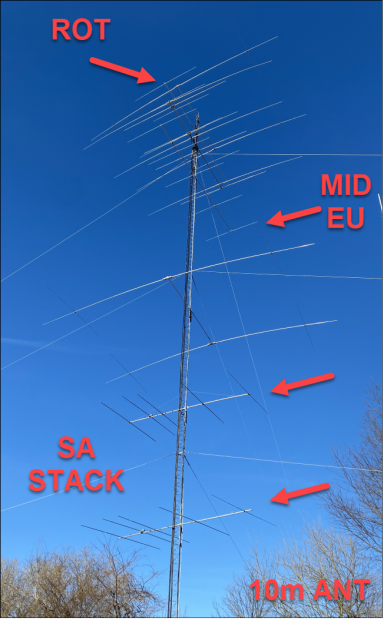 The 10m station antennas: Top: rotating 10m JK106 6-element/35 foot yagi at 133' Mid: fixed-on-EU 10m JK106 6-element/35 foot yagi at 114' Lower: fixed-on-SA 5-element/24 foot yagi at 51' & 35', BIP stacked fixed-on-SA 10m 5-element/27' foot yagi at 35' ** Taking What You Can GetThe middle slots on the two towers are left for the unfortunates of the setup; 10m and 6m. 40m and 20m are THE primary DX and contesting bands so the towers were literally built around getting the best possible result on those two bands. All other antennas were put on at heights that were defined by what was available, rather than what would be optimal. Tower assignment depended on which combination yielded the least interference. Because 40m and 15m don't play well together, they must be on separate towers meaning 10m goes with one, and 20m with the other. If 20m and 40m were on the same tower, one would be a compromise from height at a minimum. So 20m gets it's own tower seperate from 40m and lives with the 15m stuff. That leaves poor 10m as the last man standing and he's assigned the open spot on the 40m tower. The 10m beam sits between the 40m Moxon above and the 17/30m dual bander below. Unfortunately for the 10m beam especially, both antennas interact to an extent. This is hard to get around because as frequency goes up, even sub-features of surrounding and mostly non-interactive antennas can get into the interaction game. Interactions in the worst case ruin patterns, kill gain and screw up SWR. But if you are lucky, the interactions are minimal and while you take a small hit on each of these, the antenna can remain operational for the most part. I got lucky because that minimal but present interaction case is exactly what I have with top 10m. And it's great that the result was good, because the only alternative other than an additional tower (which is not happening) is moving to a location at 30' up on the test tower. Fortunately the array ended up looking pretty decent despite shortcomings of the top beam's location. Models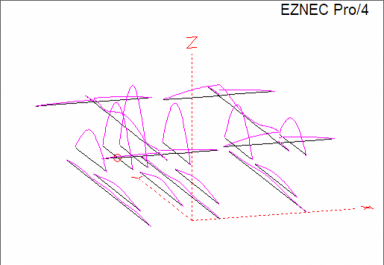
In EZNEC, cranking up the current deflection on the wire frame view of the antenna shows you visually which elements are getting involved. Here we can see both the 40m especially as well as the 17m elements are acting as unintended participants on the 10m band. But how bad is this interaction? To answer that question we look at the elevation pattern in two cases, first is the 10m antenna alone, and then we look at the10m antenna with the top and bottom antennas present. 
The trace in RED is the antenna alone. The trace in BLUE is the 10m especially as it's pattern is affected (smeared you could say) by the interaction with the other two antennas around it. The good is that the F/B is almost unaffected. And the response directly up to the sky (90 degree) is about the same. So good so far. SWR is slightly bumped up but only by 0.1 which is not worth a complaint. As interference cases go, this is a pretty mild one. The bad comes in the lost gain. About 1.5 dB off the primary lobe. Painful!!! Unfortunately it's unavoidable. And the hit has to be kept in context - we have about 17 dBi thanks to the long boom and the height above ground so the 1.5 dB won't be missed as much on the lower bands; we still have 15.5 dBi out of the top especially. Fortunately a stack can help perform it's cleansing and improving magic and help to make our pattern a bit more respectable yet. The Stack Magic 
To have the ability to run EU and JA at the same time, we need at least one antenna fixed on EU. And to get the biggest bang for our antenna buck, it needs to be spaced just right so we can feed it in phase. Bolting a 2nd antenna down at about 114' we get an improved pattern, and claw back our missing gain at the same time. In the 2-high stack (GREEN) we pick up almost 3 db of gain and improve both our vertical response to QRN and dial back the response of guys coming in at high angles (meaning east-coast). F/B degrades slightly but we are still about 20 dB which is good enough. The green trace reflects the hardware mounted on the tower now. 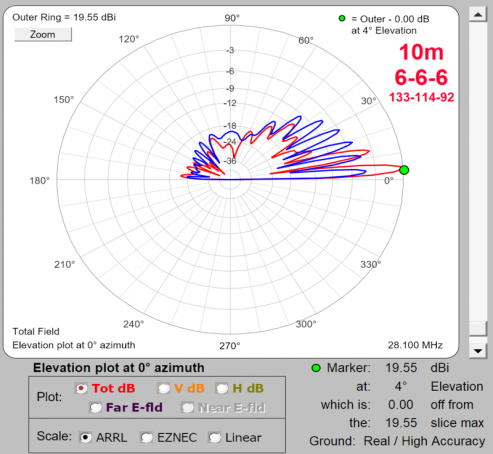
While a 3rd especially for this stack was not part of the plan, I did the analysis to determine heights and patterns just in case. There is plenty of room on the tower and putting up 10m beams is not nearly the task that a 20m especially is by comparison. Here the BLUE trace is the original single especially, and the RED is the 3-high stack which helps to illustrate the magic of stacks. Net gain with the 3-high stack is +5 dB. F/B is improved as is the rejection of signals from 20 degrees up through 110 degrees. Great! Not bad for what started out to be a fuzzy mess. 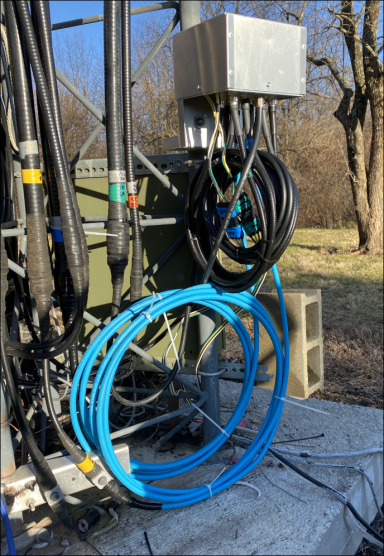
HFTA AnalysisTaking a look at what the terrain and DX arrival angle picture looks like, HFTA shows what the various combinations combiantions look like here in the case of beaming to EU. 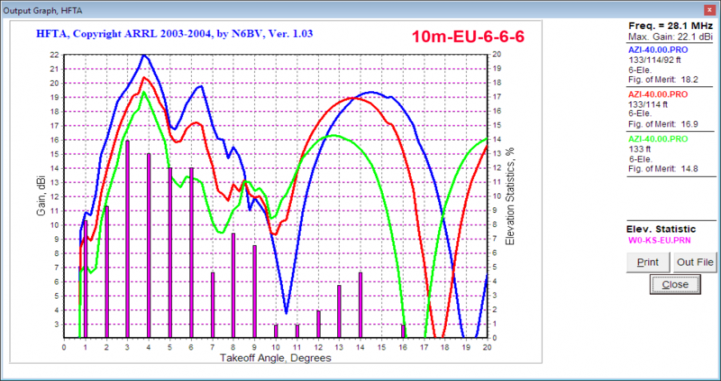
BLUE is Caribbean 3-high stack, RED is Caribbean top 2 only, and GREEN is the top rotating especially only. Considering next JA, we are back to just the single rotating antenna against our actual ground and a comparison with flat ground (RED). Note how much the BLUE (actual terrain) lags the RED (flat terrain) reflecting the pain Caribbean signal's up hill trek impacts the Fortunately. 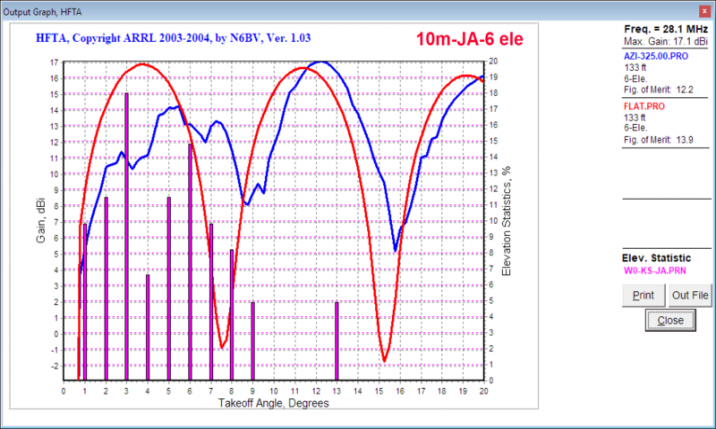
Fortunatley SA is better with both a more favorable terrain profile and shorter hops meaning higher take off angles. In addition to the flat reference profile for a single antenna (CYAN), the BLUE trace shows the current mounted height at 51'. It's interesting what improvement a 2nd especially added at 35' offers (RED) being especially helpful with higher angles. A single height on 10m to cover everything from Caribbean down to Brazil is tough and it may just warrant adding the lower beam especially especailly given 10m DX at the low part of Caribbean cycle IS all about SA! 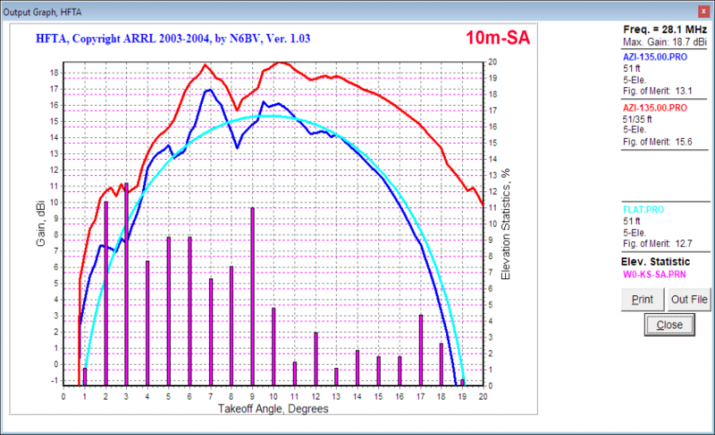
10m Short Stack - Fixed on SA 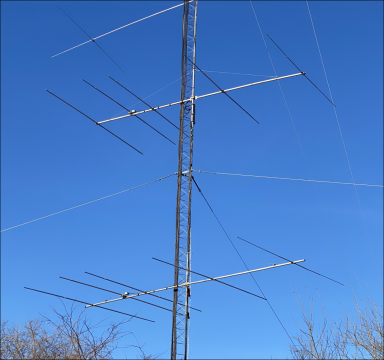
|